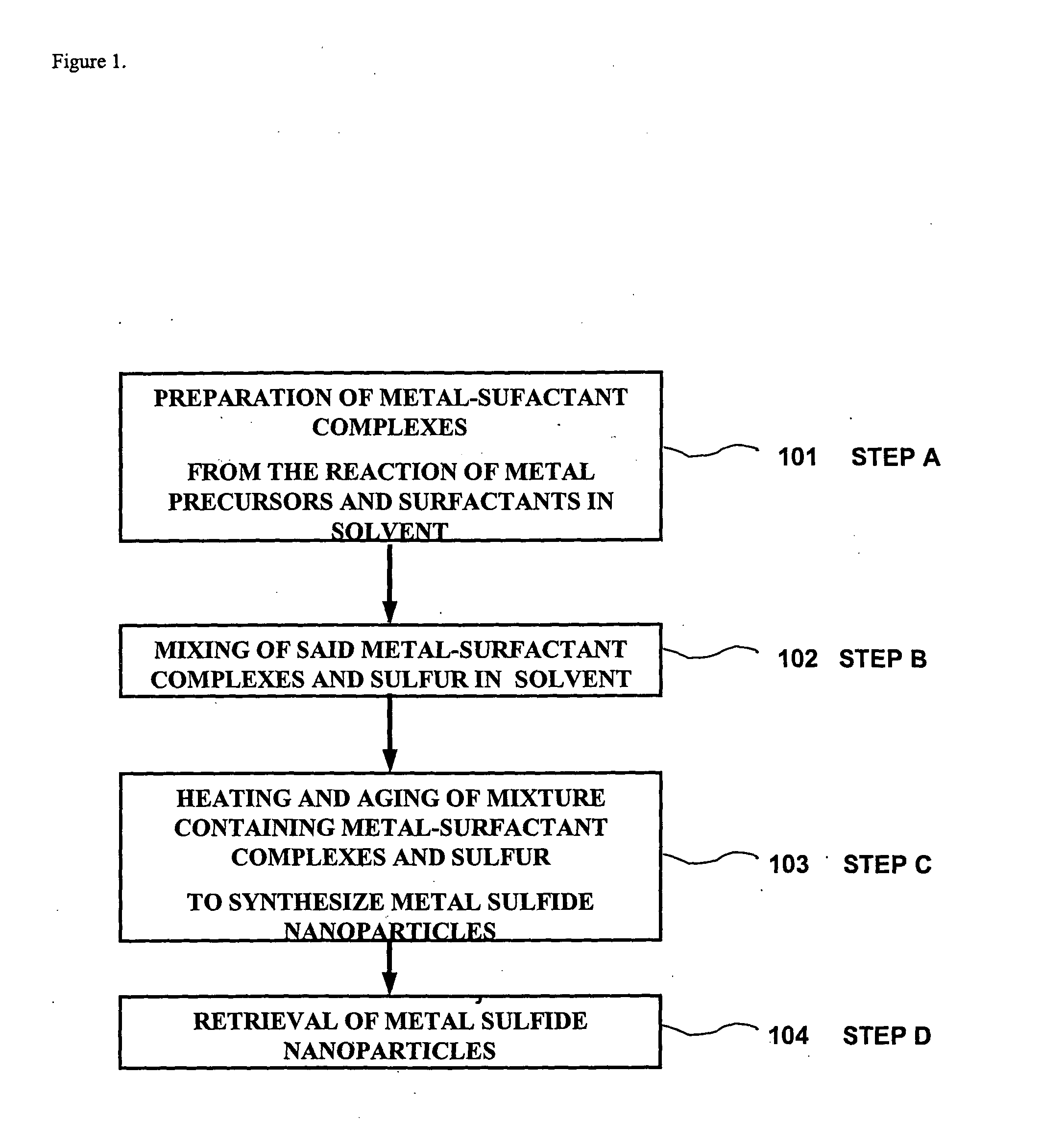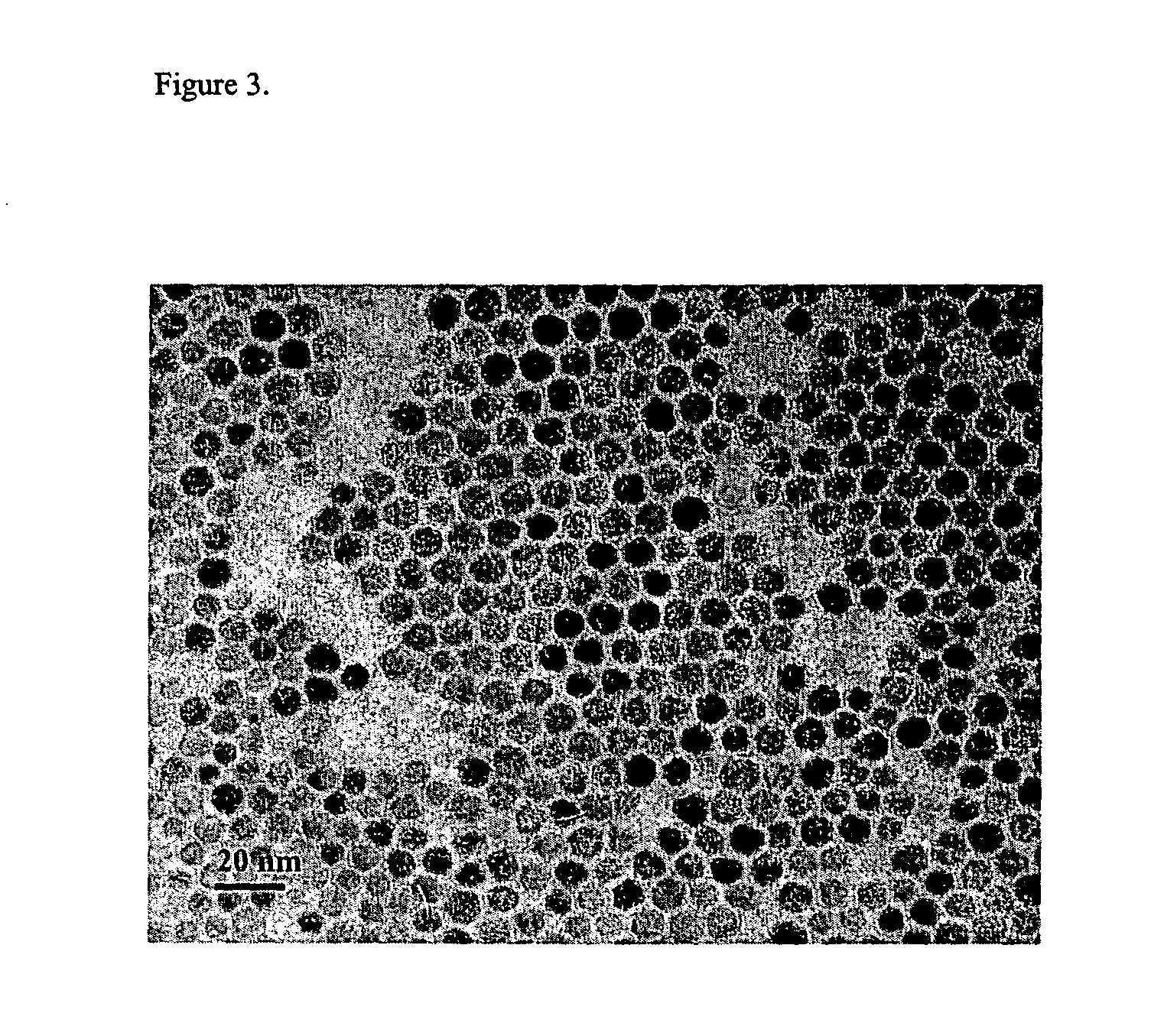Method for synthesizing nanoparticles of metal sulfides
a metal sulfide and nanoparticle technology, applied in the direction of lead sulfide, chemistry apparatus and processes, cell components, etc., can solve the problems of high toxicity of synthesizing sufide nanoparticles, hampered large-scale and economical synthesis, and high cost of such semiconductor nanoparticles
- Summary
- Abstract
- Description
- Claims
- Application Information
AI Technical Summary
Problems solved by technology
Method used
Image
Examples
embodiment 1
[0043] Synthesis of Monodisperse and Spherically Shaped Zinc Sulfide Nanoparticles
[0044] As a first exemplary embodiment of synthesizing monodisperse and spherically shaped zinc sulfide nanoparticles according to the present invention disclosed here, zinc-oleylamine solution was prepared by heating 10 ml of oleylamine and 2.3 g of TOPO containing 2 mmol of ZnCl2 at 170° C. for 1 hour. 6 mmol of sulfur dissolved in 2.5 ml oleylamine was injected to zinc-oleylamine solution at room temperature. This mixture was heated to 320° C. and aged for 1 hour at the same temperature. The resulting solution was cooled to room temperature, and ethanol was added to yield a white precipitate, which was then separated by centrifuging. The resulting supernatant was discarded. After repeating this washing process at least three times, remaining ethanol was removed by vacuum drying. The resulting product was re-dispersed easily in hexane. The TEM(Transmission Electron Microscope) image of the resulting...
embodiment 2
[0045] Synthesis of Monodisperse 13 nm Sized Lead Sulfide Nanoparticles
[0046] One (1) mmol of PbCl2 (0.28 g) was added to 5 mL of oleylamine at room temperature and the resulting solution was heated to 90° C. under vacuum, forming a homogeneous and clear solution. 0.83 mmol of elemental sulfur (27 mg) was dissolved in 2.5 mL of oleylamine, and the resulting sulfur solution was injected into the Pb-oleylamine complex solution at 90° C. The resulting mixture was heated to 220° C. and aged at that temperature for 1 hour, resulting in a black colloidal solution. The resulting solution was cooled to room temperature, and ethanol was added to yield a deep blue colored precipitate, which was then separated by centrifuging. The resulting supernatant was discarded. After repeating this washing process at least three times, remaining ethanol was removed by vacuum drying. The resulting product was re-dispersed easily in hexane to form desired PbS nanoparticles. The transmission electron micro...
embodiment 3
[0047] Synthesis of Monodisperse 9 nm Sized Lead Sulfide Nanoparticles
[0048] Monodisperse lead sulfide nanoparticles of 9 nm in diameter were synthesized using the same reaction conditions described in Embodiment 3, except that the amount of the sulfur used is reduced to 0.67 mmol (21 mg). An exemplary TEM image of the 9 nm sized lead sulfide nanoparticles synthesized according to the present invention is as shown in FIG. 7, indicating that monodisperse 9 nm sized lead sulfide nanoparticles are produced.
PUM
| Property | Measurement | Unit |
|---|---|---|
| reaction temperature | aaaaa | aaaaa |
| diameter | aaaaa | aaaaa |
| diameter | aaaaa | aaaaa |
Abstract
Description
Claims
Application Information
 Login to View More
Login to View More - R&D
- Intellectual Property
- Life Sciences
- Materials
- Tech Scout
- Unparalleled Data Quality
- Higher Quality Content
- 60% Fewer Hallucinations
Browse by: Latest US Patents, China's latest patents, Technical Efficacy Thesaurus, Application Domain, Technology Topic, Popular Technical Reports.
© 2025 PatSnap. All rights reserved.Legal|Privacy policy|Modern Slavery Act Transparency Statement|Sitemap|About US| Contact US: help@patsnap.com



